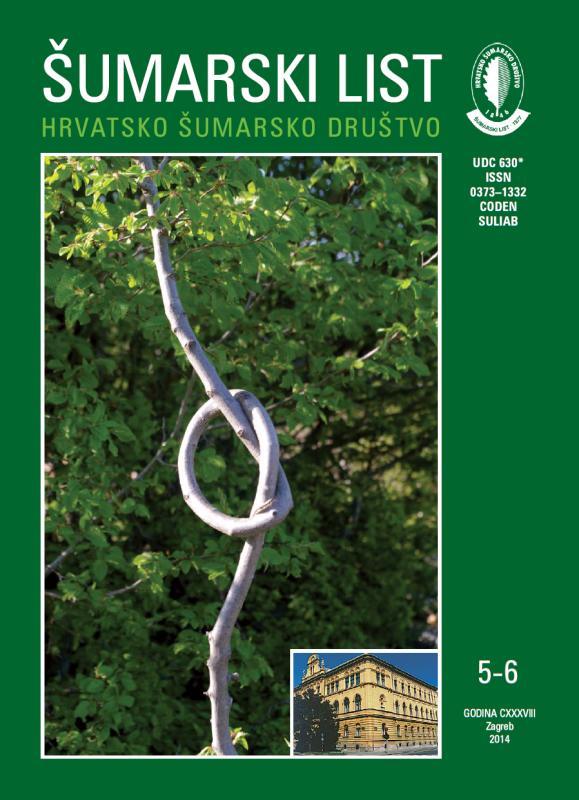
broj: 5-6/2014
pdf (6,49 MB) |
|
||||||||||||||
| RIJEČ UREDNIŠTVA | ||
| Uredništvo | ||
| WHY ARE WE SURPRISED? pdf HR EN | 257 | |
| IZVORNI ZNANSTVENI ČLANCI | ||
| Boštjan Surina | UDK 630*187+182 (001) | |
| FOREST VEGETATION OF TECTONIC DOLINES PIHLJA AND VITRA ABOVE THE VINODOL VALLEY (LIBURNIAN KARST, NW CROATIA) pdf HR EN | 259 | |
| Vesna Krpina, Željko Španjol, Anamarija Jazbec | UDK 630*907 + 971 (001) | |
| THE ROLE OF FORESTS AND FORESTRY IN TOURISM AND NATURE PROTECTION IN THE ZADAR COUNTY AREA pdf HR EN | 271 | |
| Marko Vucelja, Josip Margaletić, Linda Bjedov, Mario Šango, Maja Moro | UDK 630*451 (001) | |
| SMALL RODENT DAMAGE ON STEM AND ROOT OF PEDUNCULATE OAK (Quercus robur L.) pdf HR EN | 283 | |
| Summary Small rodents from subfamilies Murinae (real mice) and Arvicolinae (voles) during the years of their mass occurrence can impede natural regeneration of pedunculate oak (Quercus robur L.) forests by causing damage to seeds, stem and roots of young plants.. Such damage on different tree species is being recorded throughout Europe periodically. In Croatian forestry an area size on which rodent damage occures in the years of their high abundance extends on 4500 hectars on average. The mere observing of the damage and of rodent presence is the most common method of evaluating rodent abundance while thorough analysis of the two is generally missing.The aim of this research was to conduct qualitative and quantitative analysis of rodent damage made to stem and root system of pedunculate oak saplings in accordance to rodent abundance, dynamics and population structure in young-growth pedunculate oak forest (Genisto elatae – Quercetum roboris Ht. 1938) situated within the region of Central Posavina (Lipovljani, Opeke). Quantitative analysis included monitoring of rodent abundance (linear transect method, three transects, 112 snap traps) and counting oak saplings on five experimental plots (5m 5m) where saplings that had gnawing marks on their stem or roots were sampled and counted as damaged. Qualitative analysis included measuring dimension of gnawing marks (widh x hight) along with scaning, analysing and comparing damaged and undamaged root systems of sampled oak saplings. The latter was done using scaner Epson Expression 10000 XL while the WinRhizo software was used to determine root varables: lenght, volume and the number of root tips. Data classification of the root lenght and number of root tips was made in accordance to four categories depending on the diamentar of root sections: 0–1 mm, 1–2 mm, 2–5 mm, > 5 mm. Roots of 115 damaged and 33 undamaged oak saplings was sampled, scaned and sorted into three categories depending on a plant hight: <40 cm, 40–80 cm, >80 cm. Plant and rodent sampling were done in November 2011, April 2012 and in May 2013. Morphological determination of rodents was done according to Niethammer and Krapp. Georeferencing of trapped animals was made using the GPS (Garmin Oregon 450). Collected data was analysed using Garmin MapSource ver. 6.16.3., Microsoft Office Excel 2007 and STATISTICA 8. Differences between undamaged and damaged roots of the saplings were tested by Student t-test, or in case of inhomogeneous variences, by nonparametric Mann-Whintey U-test. In all the analyzes 5 % error was considered statistically significant. Monitoring of the rodent population showed that in period from November 2011 till May 2013 rodent abundance varied from 0 % to 16 % and that ratio of subfamilies Arvicolinae and Murinae changed seasonally (Graph 1). Analysis of the rodent spatial distribution showed that most of real mice were trapped on transect covered by dense vegetation, while voles were mostly trapped on other two transects with less vegetation coverage. Quantitative analysis showed that the ratio of damaged pedunculate oak saplings varied from 0,0 % to 42,05 % within individual experimental plots, while the highest overall recorded ratio was 22 %. Qualitative analysis showed that the extent of damage made by rodents increased with the age of oak saplings (1–5 years), both on the root system (Graphs 2–6) and on the stam. Feeding on the stems of the saplings resulted in gnawing marks that varied from 16,5 mm2 to 766,5 mm2 in size and were 182,5 mm2 on average. Number of gnawing marks recorded on individual plant varied from one to five and was 1,6 on average. Rodent feeding on root system resulted in loss of 57–77 % of root volume, 71 %–97 % of root lenght and 65 %–96 % of root tips of pedunculate oak saplings depending on the hight of a plant. Statistically significant difference in volume, rooth lenght and number of root tips between damaged and undamaged oak saplings within almost all high and root categories was determened. This research confirmed that rodent abundance and population structure varies seasonally and is therefore important to be aware of it while it provides basic information for predicting the damage made by rodents on the pedunculate young-growth. It also showed that, in accordance to root volume, lenght and number of root tips of pedunculate oak saplings damaged by rodents – that were measured for the the first time within this research – the plant itself cannot recover from the loss. Key words: rodents; pedunculate oak; damage; saplings; roots; stem | ||
| Gregor Meterc, Danijel Borković, Maja Jurc | UDK 630* 453 (001) | |
| OUTBREAK OF THE SPRUCE WEB-SPINNING SAWFLY Cephalcia arvensis (HYMENOPTERA: PAMPHILIIDAE) IN SLOVENIA pdf HR EN | 293 | |
| Rita Horák, Milan Borišev, Andrej Pilipović, Saša Orlović, Slobodanka Pajević, Nataša Nikolić | UDK 630*111 + 116 (001) | |
| DROUGHT IMPACT ON FOREST TREES IN FOUR NATURE PROTECTED AREAS IN SERBIA pdf HR EN | 301 | |
| PRETHODNO PRIOPĆENJE | ||
| Stjepan KRČMAR, Marija VEREŠ, Tomi TRILAR | UDK 630*453 | |
| FAUNA OF HARD TICKS (ACARI: IXODIDAE) IN DIFFERENT HABITATS IN CROATIAN PART OF BARANJA pdf HR EN | 309 | |


